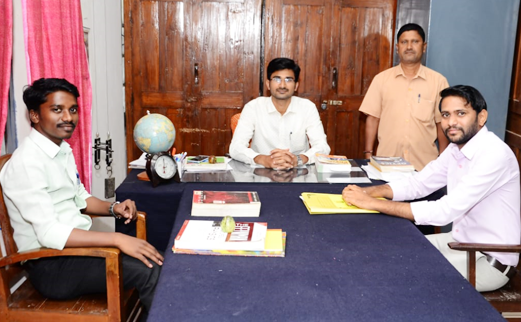|
Sl. No.
|
Name
|
Qualification
|
|
1
|
Prof. R. C. Honawad
|
M.Sc.
|
|
2
|
Prof. D. B. Mathapati
|
M.Sc.
|
|
3
|
Mr. A.H. Teli
|
M.Sc.
|
PROGRAMME OUTCOMES (POs), PROGRAMME SPECIFIC OUTCOMES (PSOs), COURSE OURTCOMES (Cos):
|
Department of Physics
|
|
Programme Outcome
|
On successful completion of this program, students would be able to:
Students will employ critical thinking and the scientific method to design, carry out, record and analyze the results of many nuclear physics experiments and get an awareness of the impact ofPhysics on the environment, society, and other cultures outside the scientific community.
Physics deals with a wide variety of systems; certain theories are used by all physicists. Each of these theories were experimentally tested numerous times and found to be an adequate approximation of nature. Physics uses mathematics to organize and formulate experimental results. From those results, precise or estimated solutions, quantitative results from which new predictions can be made and experimentally confirmed or negated. The results from physics experiments are numerical measurements. Technologies based on mathematics, like computation have made computational physics an active area of research.
|
|
Programme Specific Outcome
|
The theory of classical mechanics(it is a branch of physics) accurately describes the motion of objects, provided they are much larger than atoms and moving at much less than the speed of light. These theories continue to be areas of active research today. Similarly, Quantum Mechanics, Nuclear & Particle Physics and other mechanics.
The design and execution of the experiment should demonstrate an understanding of good laboratory and the proper handling of equipment’s like radioisotopes and also explain how the applications of Physics relates to the real world.
|
|
Course Outcomes
|
|
Courses
|
Outcomes
|
|
Mechanics, Properties of Matter and Sound
|
To gain the knowledge the students in order to, Learn motion of bodies and sound waves
|
|
Acquire basic knowledge of mechanics, properties of matter and
gravitation
|
|
Know how to apply the conservation of rotational motion
|
|
Thermo Dynamics
|
To aim is to provide the basic concepts of Thermodynamics
|
|
To understand the principle of calorimetry
|
|
Understand the basic principle and laws of Thermodynamics
|
|
Able to understand kinetic theory of gases and thermal conductivity.
Able to understand conversion of heat energy into other form of energy.
|
|
Optics
|
To provide a good foundation in optics
Able to understand about properties of light and their applications.
|
|
To provide a knowledge of the behavior of light
|
|
To inspire interest for the knowledge of concepts is physical and geometrical physics
|
|
Atomic Physics and Spectroscopy
|
To provide a detailed study of atom & Vector Model of the Atom
|
|
To learn the impact of magnetic fields in spectra
|
|
To learn the behavior of atom in various states
|
|
To provide a knowledge of the application of observed theories
|
|
Mathematical Physics
|
To acquire knowledge and apply it to various physical problems
|
|
To apply the develop the problem solving ability
|
|
To motivate the students to apply matrices or solving problems in spectroscopy, nuclear physics
|
|
To understand Frobenius Method and Special Functions
|
|
Electronics
|
To acquire knowledge and apply it to various electronically instruments
|
|
To apply the development of the electronic instruments
|
|
To motivate the students to apply the principles of electronics in their day-to-day life.
|
|
Electricity and Magnetism
|
To gain knowledge about the electrical energies in order to
|
|
Learn motion of charges
|
|
Acquire basic knowledge of magnetic properties
|
|
Know about the alternating current and its circuits
|
|
Get a depth knowledge about electricity and magnetism
|
|
Digital Electronics
|
To give description for the students in order to
|
|
To give basic idea to operate the device
|
|
Learn the logic gates
|
|
Acquire basic knowledge of binary addition
|
|
Understand the action and application of counters
|
|
Quantum Mechanics and Relativity
|
To acquire knowledge and apply it to various physical problems
|
|
To apply the develop problem solving ability
|
|
To motivate the students to apply Schrödinger’s equation or solving problems in Wave mechanics, Nuclear physics etc..,
|
|
Nuclear & Particle Physics
|
To acquire knowledge of subatomic particles
|
|
Study of the structure of nucleus
|
|
Know the formation of nucleus and their binding energy
|
|
To motivate the students and analyze the energy released by the nucleus during the fission and fusion process.
|
|
|
Students will be able to understand
- Special Functions
- Review of Bohr's theory of hydrogen atom, Sommerfeld's modification of the Bohr atomic model (qualitative). Spatial quantization and spinning electron…etc.
|
|
Mathematical Physics – II. Atomic Molecular and Optical Physics and Atmospheric Physics
|
- Molecular Physics: Pure rotational motion, Spectrum and selection rules; Vibrational motion, vibrational spectrum and selection rules
- Lasers Introduction; Spontaneous and stimulated emission; Einstein's coefficients and optical amplification; Population inversion etc.
|
|
|
ATMOSPHERIC PHYSICS: Fixed gases and variable gases; Temperature structure of the atmosphere etc.
|
|
|
|
[elementor-template id="1582"]
EVENTS:
- On 22nd July 2020 the National level e-Quiz Competition has beenconducted on the topic of “Nuclear Physics”.
To inculcate in young people social, cultural and moral values by imparting education and make them responsible citizens.
[elementor-template id="1592"]
Address for the Correspondence:
Mr. A.H.Teli
Head, Department of Physics
Laboratory Section, 1st Floor
VMKSR Vastrad Arts, Science & VS Bellihal Commerce College,
Hungund-587118
Mobile Number: 9611953795
E-mail id:
vmksrphysicsdept@gmail.com
E-mail id:
anand1993phy@gmail.com

 Skip to content
Skip to content